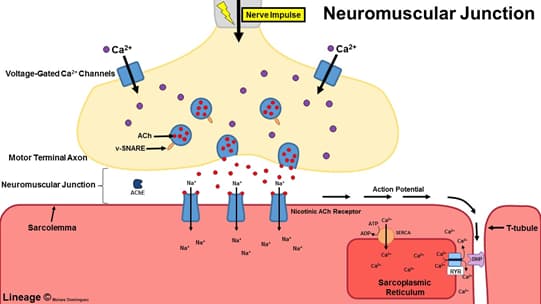Snapshot
- A 36-year-old male presents with ascending muscle weakness. The patient is generally healthy, with no pertinent past medical history. He states he recently recovered from diarrhea that has lasted over a week. Neurological examination is notable for weakness in the lower extremities and an abscence of patellar reflexes. (Botulinum toxin)
Introduction
- Action Potential Overview
- initiation
- neuronal membrane potential becomes more positive → opening of voltage gated Na+ channels
- positive feedback loop
- threshold is reached → action potential generated
- neuronal membrane potential becomes more positive → opening of voltage gated Na+ channels
- propagation
- action potential generated at one portion of neuron → excitation of adjacent neuronal membrane
- signal thus propagates down the axon via opening of voltage gated Na+ channels
- action potential generated at one portion of neuron → excitation of adjacent neuronal membrane
- neuromuscular junction
- when the propagated action potential reaches the presynaptic neuron, it becomes depolarized
- this opens voltage gated Ca2+ channels
- allows release of acetylcholine (ACh) from stored vesicles in the presynaptic neuron
- this opens voltage gated Ca2+ channels
- released ACh act on nicotinic receptors (a ligand-gated ion channel) on the motor end plate
- when the propagated action potential reaches the presynaptic neuron, it becomes depolarized
- initiation
- motor end plate depolarizes, and propagates the action potential down the muscle fiber, ultimately leading to muscle contraction
Action Potential Initiation

- Initiation
- initial depolarization → opening of voltage gated Na+ channels
- increased Na+ inflow → opening of more voltage gated Na+ channels (positive feedback loop)
- threshold is eventually met → action potential generation
- clinical correlate
- tetrodotoxin (pufferfish consumption) binds fast voltage-gated Na+ channels in nerve tissue, which does not allow for depolarization or action potential formation
- can result in nausea, weakness, dizziness or can be fatal
- tetrodotoxin (pufferfish consumption) binds fast voltage-gated Na+ channels in nerve tissue, which does not allow for depolarization or action potential formation
- increased Na+ inflow → opening of more voltage gated Na+ channels (positive feedback loop)
- initial depolarization → opening of voltage gated Na+ channels
- treatment is supportive
Action Potential Propagation
- Propagation
- depolarized region of the neuronal membrane → excitation of adjacent neuronal membrane
- myelinated neurons
- Schwann cells myelinates axons of the peripheral nervous system (PNS)
- myelinates only 1 axon
- increases conduction velocity
- non-myelinated areas are called Nodes of Ranvier
- contains a high concentration of Na+ channels
- allows “jumping” of action potential from one Node of Ranvier to the next
- this is saltatory conduction
- allows “jumping” of action potential from one Node of Ranvier to the next
- contains a high concentration of Na+ channels
- clinical correlate
- Guillain-Barre syndrome
- autoimmune destruction of peripheral myelinated neurons
- classically associated with previous Campylobacter jejuni infection
- autoimmune destruction of peripheral myelinated neurons
- Guillain-Barre syndrome
- Schwann cells myelinates axons of the peripheral nervous system (PNS)
- non-myelinated neurons
- transmit potentials via Na+ channels that exist along the entire length of the axon (no Nodes of Ranvier)
- have same refractory period of Na+ channels as myelinated axons do but at a slower velocity of conduction due to lack of insulation (myelin)
Neuromuscular Junction

- Neuromuscular junction
- propagated action potential reaches presynaptic neuron → opens voltage gated Ca2+ channels
- clinical correlate
- Lambert-Eaton syndrome
- autoantibodies against the presynaptic calcium channels → reduced ACh release → weakness
- associated with small cell carcinoma of the lung
- Lambert-Eaton syndrome
- clinical correlate
- Ca2+ influx → ACh release with the help of SNARE proteins
- clinical correlate
- botulinum toxin
- cleaves SNARE proteins → decreased ACh release → flaccid paralysis
- tetanus toxin
- cleaves SNARE proteins → decrease release of inhibitory neurotransmitters (GABA and glycine) in the spinal cord → spasticity and overactivity
- botulinum toxin
- clinical correlate
- released ACh act on nicotinic receptors (ligand gated ion channels) of the motor end plate
- clinical correlate
- myasthenia gravis
- autoantibodies bind the post-synaptic ACh receptor → weakness
- myasthenia gravis
- clinical correlate
- depolarization travels along the muscle cell via T-tubules, which are invaginations that allow for the skeletal muscle to be depolarized
- dihydropyridine receptors are then depolarized
- mechanically coupled to ryanodine receptors (Ca2+ release channels) on the sarcoplasmic reticulum
- increases intracellular Ca2+ concentration → binds to troponin C → cross bridge cycle
- clinical correlate
- malignant hyperthermia
- ryanodine or dihydropyridine receptor mutation → unregulated Ca2+ release into the muscle cytoplasm → sustained muscle contraction → increased aerobic metabolism → depletion of O2, ATP, and increased CO2 production and acidosis
- treatment: dantrolene
- malignant hyperthermia
- mechanically coupled to ryanodine receptors (Ca2+ release channels) on the sarcoplasmic reticulum
- propagated action potential reaches presynaptic neuron → opens voltage gated Ca2+ channels


